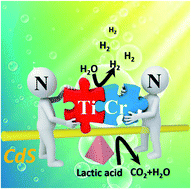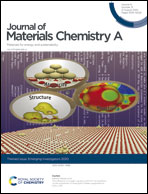Chromium-titanium nitride as an efficient co-catalyst for photocatalytic hydrogen production†
Abstract
Transition metal nitrides (TMNs) are emerging as a feasible alternative to noble metal co-catalysts in photocatalytic hydrogen production. Considering the recent prospects created by multicomponent systems, it is reasonable to investigate multi-component TMNs for photocatalytic hydrogen production. Herein, in an effort in that direction, ternary chromium-titanium nitride (Cr0.5Ti0.5N) nanoparticles have been synthesized by a solid–solid phase separation method, resulting in highly efficient co-catalysts for promoting photocatalytic hydrogen production of semiconductors under visible light irradiation. Both experimental results and density functional theory (DFT) calculations demonstrate that ternary Cr0.5Ti0.5N offers a comprehensive advantage by boosting the photo-induced charge carrier separation and migration, improving the reaction kinetics as compared to those of TiN and CrN. Therefore, the optimal Cr0.5Ti0.5N-based sample exhibits the highest photocatalytic hydrogen evolution rate of 2.44 mmol g−1 h−1, and has ∼120 times better kinetics than the reference pure CdS sample. In fact, this result even surpasses that of Pt-based nanocomposites (2.06 mmol g−1 h−1).

- This article is part of the themed collection: Journal of Materials Chemistry A Emerging Investigators


 Please wait while we load your content...
Please wait while we load your content...